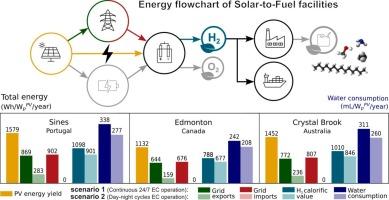Multi-scale solar-to-hydrogen system design: An open-source modeling framework
IF 6
2区 工程技术
Q2 ENERGY & FUELS
引用次数: 0
Abstract
Hydrogen produced from renewable energy holds significant potential in providing sustainable solutions to achieve Net-Positive goals. However, one technical challenge hindering its widespread adoption is the absence of open-source precise modeling tools for sizing and simulating integrated system components under real-world conditions. In this work, we developed an adaptable, user-friendly and open-source Python® model that simulates grid-connected battery-assisted photovoltaic-electrolyzer systems for green hydrogen production and conversion into high-value chemicals and fuels. The code is publicly available on GitHub, enabling users to predict solar hydrogen system performance across various sizes and locations. The model was applied to three locations with distinct climatic patterns – Sines (Portugal), Edmonton (Canada), and Crystal Brook (Australia) – using commercial photovoltaic and electrolyzer systems, and empirical data from different meteorological databases. Sines emerged as the most productive site, with an annual photovoltaic energy yield 39 % higher than Edmonton and 9 % higher than Crystal Brook. When considering an electrolyzer load with 0.5 WEC/WpPV capacity solely powered by the photovoltaic park, the solar-to-hydrogen system in Sines can reach an annual green hydrogen production of 27 g/WpPV and export 283 Wh/WpPV of surplus electricity to the grid. Continuous 24/7 electrolyzer operation increased the annual hydrogen output to 33 g/WpPV, with a reduced Levelized Cost of Hydrogen of €6.42/kgH2. Overall, this work aims to advance green hydrogen production scale-up, fostering a more sustainable global economy.

多尺度太阳能制氢系统设计:开源建模框架
可再生能源生产的氢气在提供可持续解决方案以实现净正目标方面具有巨大潜力。然而,阻碍其广泛采用的一个技术挑战是缺乏开源的精确建模工具来确定和模拟现实世界条件下的集成系统组件。在这项工作中,我们开发了一种适应性强、用户友好且开源的Python®模型,该模型模拟了用于绿色氢生产和转化为高价值化学品和燃料的并网电池辅助光伏电解槽系统。代码在GitHub上是公开的,使用户能够预测太阳能氢系统在不同规模和位置的性能。该模型应用于三个具有不同气候模式的地点——锡尼斯(葡萄牙)、埃德蒙顿(加拿大)和克里斯托布鲁克(澳大利亚)——使用商业光伏和电解槽系统,以及来自不同气象数据库的经验数据。锡恩斯成为了产量最高的地方,每年的光伏发电量比埃德蒙顿高39%,比克里斯托布鲁克高9%。考虑到仅由光伏园区供电的电解槽负荷为0.5 WEC/WpPV时,sinines的太阳能制氢系统可达到年绿色制氢27 g/WpPV,并向电网输出283 Wh/WpPV的剩余电力。连续24/7的电解槽运行将年氢气产量提高到33 g/WpPV,氢气的平均成本降低了6.42欧元/kgH2。总的来说,这项工作旨在推动绿色氢生产的规模扩大,促进更可持续的全球经济。
本文章由计算机程序翻译,如有差异,请以英文原文为准。
求助全文
约1分钟内获得全文
求助全文
来源期刊

Solar Energy
工程技术-能源与燃料
CiteScore
13.90
自引率
9.00%
发文量
0
审稿时长
47 days
期刊介绍:
Solar Energy welcomes manuscripts presenting information not previously published in journals on any aspect of solar energy research, development, application, measurement or policy. The term "solar energy" in this context includes the indirect uses such as wind energy and biomass
 求助内容:
求助内容: 应助结果提醒方式:
应助结果提醒方式:


